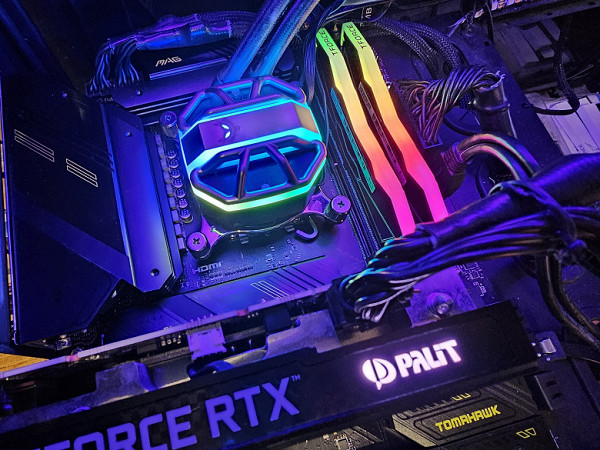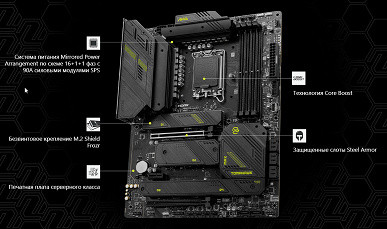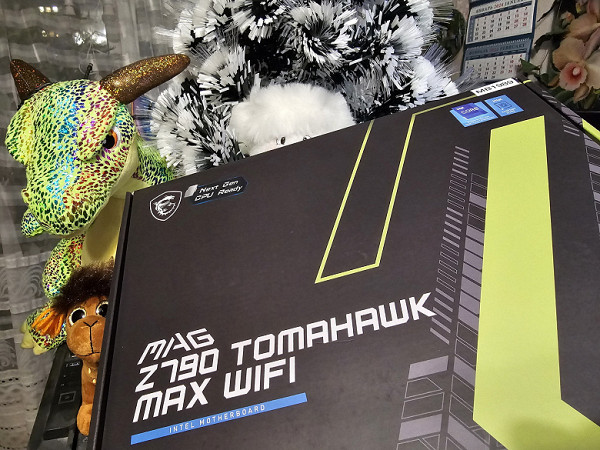
we are engaged in further study of motherboards based on Intel Z790, which are entering our market.
Let's look at the differences between system chipsets of the last 4 generations.
| Peculiarities | Z790 | Z690 | Z590 | Z490 |
|---|---|---|---|---|
| Compatible with Intel processors | 14th/13th/12th Gen Core | 14th/13th/12th Gen Core | 10th & 11th Gen Core | 10th & 11th Gen Core |
| PCIe version (CPU) | 4.0 & 5.0 | 4.0 & 5.0 | 3.0 (10th Gen) or 4.0 (11th Gen) | 3.0 (10th Gen) or 4.0 (11th Gen) |
| Number of PCIe lanes (processor) | 20 | 20 | 16 (10th Gen) or 20 (11th Gen) | 16 |
| PCIe version (chipset) | 3.0 & 4.0 | 3.0 & 4.0 | 3.0 | 3.0 |
| Number of PCIe lanes (chipset) | 28 (20 x 4.0 & 8 x 3.0) | 28 (12 x 4.0 & 16 x 3.0) | 24 | 24 |
| DMI version | 4.0 | 4.0 | 3.0 | 3.0 |
| Number of DMI lines | x8 | x8 | x8 | x4 |
| RAM generation | DDR4 & DDR5 | DDR4 & DDR5 | DDR4 | DDR4 |
| Number of RAM channels | 2 | 2 | 2 | 2 |
| Maximum number of RAM slots | 4 | 4 | 4 | 4 |
| Maximum RAM | 128 GB | 128 GB | 128 GB | 128 GB |
| Number of SATA 6.0 Gb/s ports up to | 8 | 8 | 6 | 6 |
| USB 3.2 Gen 2x2 (20Gbps) ports up to | 5 | 4 | 3 | 0 |
| USB 3.2 Gen 2x1 ports (10Gbps) up to | 10 | 10 | 10 | 6 |
| USB 3.2 Gen 1x1 ports (5Gbps) up to | 10 | 10 | 10 | 10 |
| USB 2.0 ports up to | 14 | 14 | 14 | 14 |
| Built-in Wi-Fi support | Wi-Fi 6E | Wi-Fi 6E | Wi-Fi 6 | Wi-Fi 6 |
The Z790 chipset, following the traditions of its predecessor, is equipped with 38 high-speed ports (HSIO).
The Z790 also provides support for up to 5 integrated USB 3.2 Gen2x2 ports (up to 20 Gb/s), with the proviso that each requires support from two USB 3.2 Gen2 ports, whether from the Z790 or external hubs.
12th/13th/14th generation processors support PCIe 5.0 with 16 lanes used for PCIe x16 slots and an additional 4 PCIe 4.0 lanes routed to the M.2 slot receiving data directly from the processor. In terms of memory, these generations of processors are compatible with both DDR5 and DDR4.
MSI has three main segments of gaming motherboards: MEG (high end), MPG (similar to MEG, but without some overclocking features) and MAG (more affordable segment, focusing on ease of connections and minimalist design).
The review is dedicated to the MSI MAG Z790 Tomahawk Max WiFi motherboard from the MAG (MSI Arsenal Gaming) family. It belongs to the more affordable segment of gaming solutions, but still provides extensive features for a modern PC, including a variety of options for connecting peripheral devices and an efficient power system.
Unlike the previous version, MSI MAG Z790 Tomahawk WiFi (no Max suffix) has some improvements such as PCIe 5.0 support for M.2_1 slot, WiFi7 wireless adapter and other minor additions.
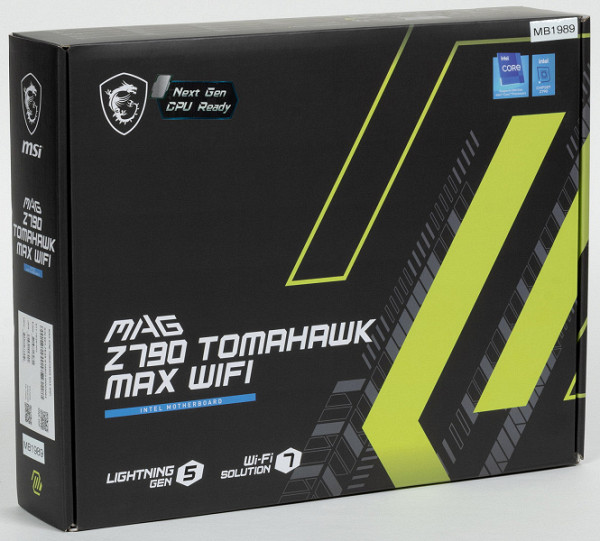
MSI MAG Z790 Tomahawk Max WiFi comes in standard packaging, where the kit is located in a separate compartment under the board.
The delivery package is extremely simple: in addition to standard elements such as a user manual and SATA cables, antennas for the built-in Wi-Fi module, additional fasteners for M.2 slots, bonus stickers, a drive with pre-installed software, and an adapter for easy connection are included front panel of the case.
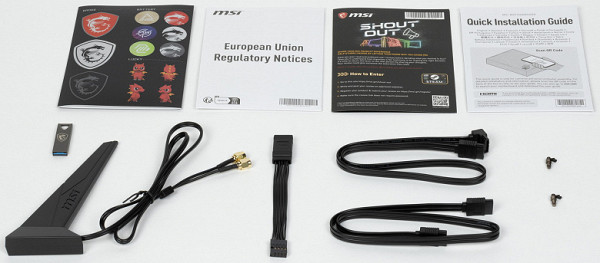
The software is supplied on a USB drive, however, during the board’s journey to the buyer, it still manages to become outdated, so you will have to download it from the manufacturer’s website immediately after purchase.
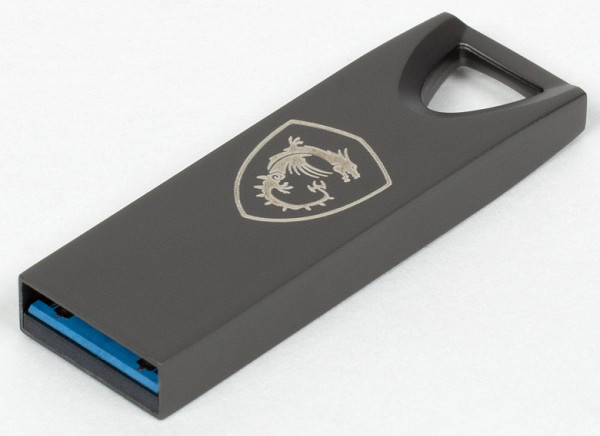
The “plug” for the rear panel with connectors is already mounted on the board itself.
Form factor
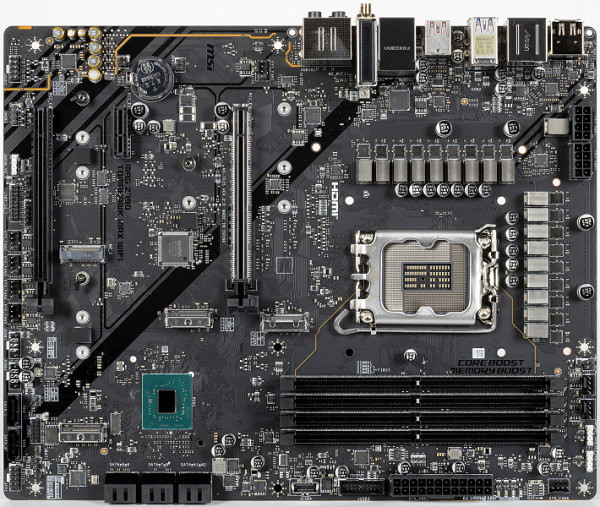
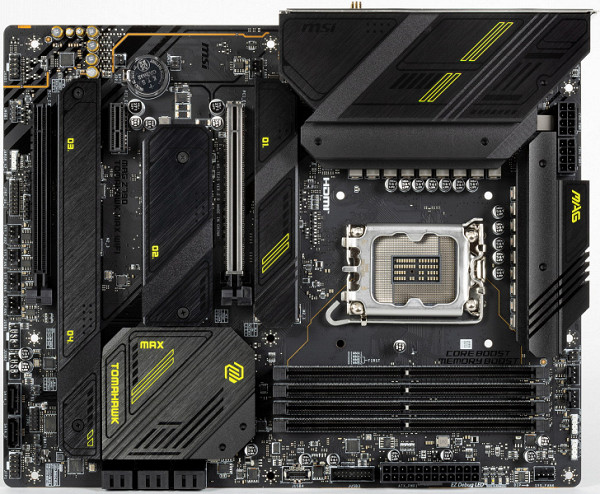
The ATX form factor has dimensions up to 305x244 mm, and E-ATX — up to 305x330 mm. The MSI MAG Z790 Tomahawk Max WiFi motherboard measures 305x244 mm, therefore is made in the ATX form factor, and it has 9 mounting holes for installation in the case.

The reverse side of the board is almost devoid of components, with the exception of some logic elements such as power phase doublers. The quality of PCB processing is high: all soldering points are not only free of sharp edges, but also carefully polished.
In keeping with tradition, on the back of all MSI motherboards there are areas where excess mounting sleeves, often made of brass, are usually located. These areas are marked with white paint and are specifically free of electrical components to avoid accidental short circuits or damage when installing the motherboard into the case.
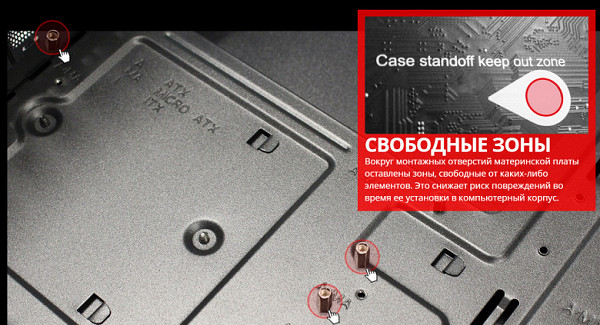
Specifications
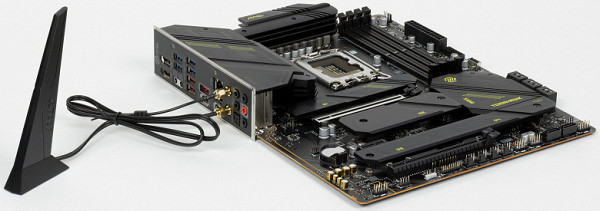
Traditional table with a list of functional features.
| Supported processors | Intel Core 12/13/14th generations |
|---|---|
| CPU socket | LGA 1700 |
| Chipset | Intel Z790 |
| Memory | 4 × DDR5, up to 7800 MHz (XMP), up to 192 GB, two channels |
| Audio subsystem | 1 × Realtek RTL4080 (7.1) |
| Network controllers | 1 × Intel I225-V Ethernet 2,5 Гбит/с 1 × Qualcomm Dual Band Wireless QCNCM865 (Wi-Fi7 802.11a/b/g/n/ac/ax/be (2,4/5/6 ГГц) + Bluetooth 5.4) |
| Expansion slots | 1 × PCIe 5.0 x16 (x16 mode) 1 × PCIe 4.0 x16 (x4 mode) 1 × PCIe 3.0 x1 (x1 mode) |
| Drive connectors | 8 × SATA 6 Gb/s (Z790+ASM1061) 1 × M.2 (M.2_1*,CPU, PCIe 5.0 x4 for 2260/2280/22110 format devices) 1 × M.2 (M.2_2,Z790, PCIe 4.0 x4 for 2260/2280 format devices) 1 × M.2 (M.2_3**,Z790, PCIe 4.0 x4/SATA for 2242/2260/2280 format devices) 1 × M.2 (M.2_4,Z790, PCIe 4.0 x4 for 2242/2260/2280 format devices) |
| USB port | 4 × USB 2.0: 2 x 4-port internal (GL850G) 4 × USB 3.2 Gen1: 4 x Type-A (blue) (GL3523) 2 × USB 3.2 Gen1: 1 x 2-port internal (GL3523) 1 × USB 3.2 Gen2x2: 1 x internal Type-C (Z790) 4 × USB 3.2 Gen2: 4 x Type-A (red) (Z790) 1 × USB 3.2 Gen2: 1 x Type-C (Z790) 1 × USB 3.2 Gen2x2: 1 x port Type-C (Z790) |
| Rear Connectors | 1 × USB 3.2 Gen2x2 (Type-C) 1 × USB 3.2 Gen2 (Type-C) 4 × USB 3.2 Gen2 (Type-A) 4 × USB 3.2 Gen1 (Type-A) 1 × RJ-45 5 audio minijacks 1 S/PDIF connector 2 antenna connectors 1 HDMI out connector 1 Display Port out connector CMOS reset button BIOS flashing button — Flash BIOS |
| Other internal elements | 24-pin ATX power connector 2 8-pin EPS12V power connector 1 M.2 slot (E-key), occupied by wireless network adapter 1 connector for connecting USB 3.2 Gen2 Type-C port 1 connector for connecting 2 USB 3.2 Gen1 ports 2 connectors 4 USB 2.0 ports 8 connectors for connecting 4-pin fans and pumps 3 connectors for connecting backlight adapters (1 connector for non-addressable RGB tape, 2 connectors for addressable ARGB tape) 1 connector for discrete Intel Thunderbolt card 1 connector for TPM 1 connector for connecting the control adapter from the front panel of the case 1 connector for Tuning Controller |
| Form factor | ATX (305×244 mm) |
| Notes | * — M.2_1 slot shares resources with PCIe x16 slot (PCI_E1) — details below. ** — M.2_3 slot shares resources with SATA ports — details below. |
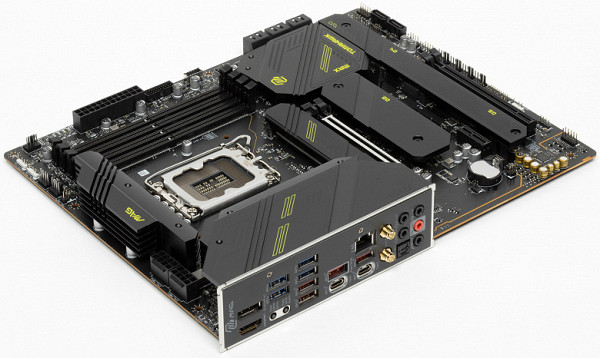
Main functionality: chipset, processor, memory

Scheme of operation of the chipset + processor combination.

The platform formally supports the use of DDR5 memory at speeds up to 5600 MHz. However, as is widely known and actively promoted by motherboard manufacturers, thanks to XMP profiles, it is now possible to achieve frequencies of up to 7000 MHz and even higher. In this case, the MSI MAG Z790 Tomahawk Max WiFi supports frequencies up to 7800 MHz (DDR5).
Intel Core 14/13/12th generation processors, compatible with the LGA1700 socket and supported by the Z790, have 20 I/O lanes (16 PCIe 5.0, 4 PCIe 4.0), do not include USB and SATA ports. Interaction with the Z790 is carried out via a unique Digital Media Interface 4.0 (DMI 4.0 x8) channel. All PCIe lines of the processor are directed to PCIe expansion slots and the M.2 port. Serial Peripheral Interface (SPI) is used to interface with the UEFI/BIOS system, and the Low Pin Count (LPC) bus is used to communicate with I/O devices that do not require high bandwidth (for example, fan controllers, TPMs, legacy peripherals).
The Z790 chipset itself supports a total of 38 I/O lines, which can be distributed as follows:
- up to 14 USB ports (including up to 5 USB 3.2 Gen2x2 ports, 10 USB 3.2 Gen2 ports, up to 10 USB 3.2 Gen1 ports, and up to 14 USB 2.0 ports; USB 2.0 lines are also used to support 3.2 ports, and each USB 3.2 Gen2x2 port requires support from two USB 3.2 Gen2);
- up to 8 SATA 6Gb/s ports;
- up to 28 PCIe lanes (8 version 3.0 and 20 version 4.0).
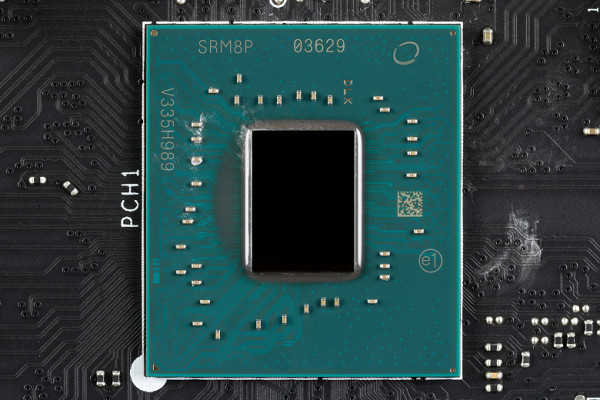
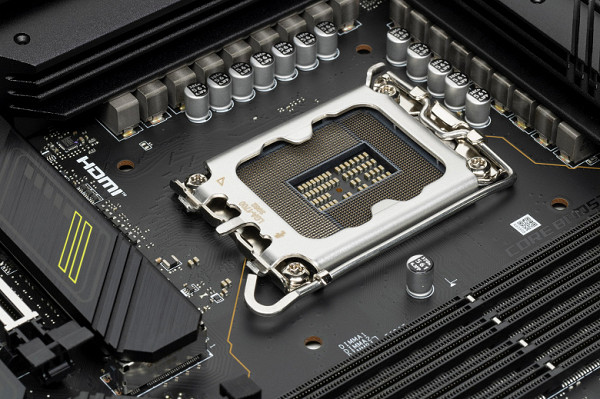
MSI MAG Z790 Tomahawk Max WiFi is equipped with four DIMM slots for installing memory modules. To activate Dual Channel mode when using two modules, it is recommended to install them in slots A2 and B2. The board supports unbuffered DDR5 (non-ECC) memory with a maximum capacity of up to 192 GB. Modules with a capacity of 24 and 48 GB are supported, as well as the use of XMP profiles.

DIMM slots do not have a metal frame, which protects them from both physical damage and interference.
Peripheral functionality: PCIe, SATA, various “baubles”
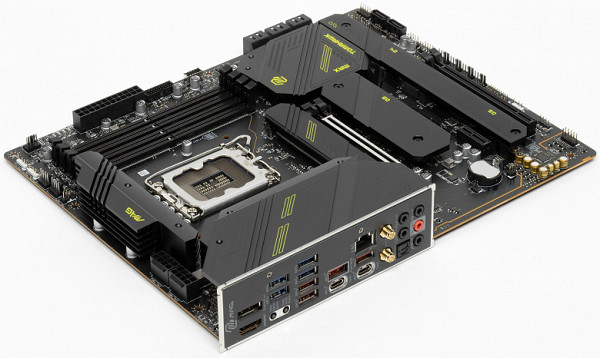
Having looked at the possibilities of combining the Z790 chipset with Intel Core processors, let's now take a closer look at how these capabilities are implemented in a specific motherboard.
In addition to USB ports, which will be discussed later, the Z790 chipset has 28 PCIe lanes. Let's consider how many lines are used to communicate with various elements (consider that 28 lines are a combination of 20 PCIe 4.0 lines and 8 PCIe 3.0 lines):
- PCIe x16_2 (PCI_E3) slot (4 PCIe 4.0 lanes);
- PCIe x1 slot (PCI_E2) (1 PCIe 3.0 lane);
- SATA_5/6/7/8 ports: 4 PCIe 3.0 lanes;
- ASMedia ASM1061 (SATA_A1/A2) (1 PCIe 3.0 line);
- M.2_2 slot (4 PCIe 4.0 lanes);
- M.2_4 slot (4 PCIe 4.0 lanes);
- Switch: either M.2_3 slot or SATA_1/2 ports (maximum 4 PCIe 4.0 lanes);
- Intel i225-V (Ethernet 2.5Gb/s) (1 PCIe 3.0 line);
- Qualcomm QCNCM865 WIFI/BT (Wireless) (1 PCIe 3.0 lane).
Thus, 24 PCIe lanes are already in use (16 PCIe 4.0 + 8 PCIe 3.0). When using modern audio codecs, communication between them and the Z790 chipset is carried out via a USB port. Also, one USB 2.0 is spent on Bluetooth support (if there is an M.2 slot (key E)), and the GL3523, GL850G controllers use USB 2.0 signal lines for their needs.
Now let's look at the performance of processors in this configuration. Intel Core processors 14/12/13th generations have only 20 PCIe lanes, 4 of which PCIe 4.0 versions are intended for the M.2 port, but they are not used in this version of the motherboard. The remaining 16 PCIe 5.0 lanes are directed to the PCIe x16_1 (PCI_E1) slot and the M.2_1 slot. Thus, there are options for distributing resources between slots:
- PCIe x16_1 (PCI_E1) slot receives all 16 PCIe 5.0 lanes, M.2_1 slot is disabled;
- The PCIe x16_1 (PCI_E1) slot receives 8 PCIe 5.0 lanes, the M.2_1 slot operates in x2/x4 modes.
In this case, in order to ensure the possibility of installing an SSD with a PCIe 5.0 interface, engineers decided to limit the number of lanes in the first PCIe slot. Unfortunately, the remaining 4 PCIe 4.0 lanes from the processor were not used. To switch slots, multiplexers from Diodes Inc. are used.
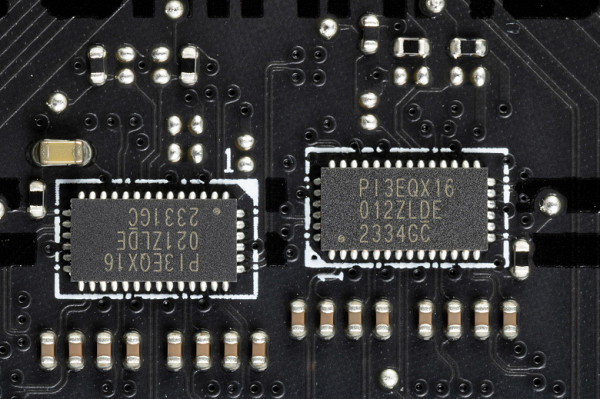
Now about PCIe slots in general.
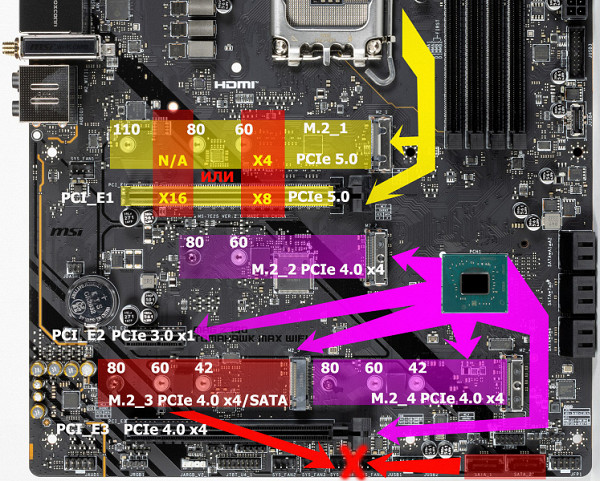
The motherboard has three slots: the first is PCIe x16_1 (PCI_E1), intended for video cards or other devices, the second is PCIe x16_2 (PCI_E3), which actually has 4 lanes and is connected to the Z790 chipset, which operates in x4 mode, and the third is PCIe_x1 (PCI_E2).
The first PCIe x16 slot is equipped with stainless steel metal reinforcement. This not only improves reliability, which can be important when changing graphics cards frequently, but also provides improved flex resistance when installing large, heavy graphics cards. In addition, such protection serves as a barrier against electromagnetic interference.
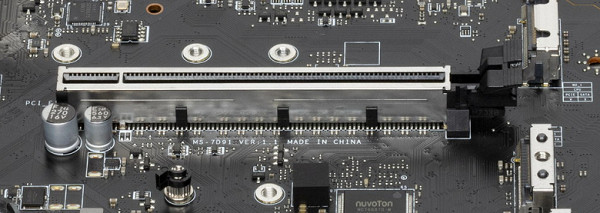
The motherboard allows you to mount a CO of any size.
Next up are storage devices.

In total, the board has 8 Serial ATA 6 Gb/s connectors + 4 slots for drives in the M.2 form factor. The SATA ports are strangely labeled: 1, 2, 5, 6, 7, 8, A1, A2. 6 of them are implemented through the Z790 chipset and support RAID creation. In this case, SATA ports 1 and 2 share resources with the M.2_3 port.

The remaining 2 SATA A1/A2 ports are implemented via ASM1061 from ASMedia.

The motherboard has 4 M.2 form factor slots.
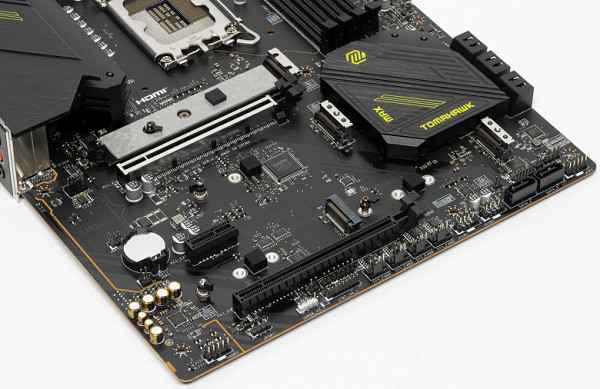
M.2 slots two, three and four on the motherboard receive data from the Z790 chipset, and all support PCIe 4.0 technology. As noted earlier, the first M.2_1 slot receives data from the CPU via PCIe 5.0 and shares lines with the first PCI_E1 slot.
The only M.2_3 slot supports modules with any interface, while the rest only work with modules using the PCIe interface.
All M.2 slots support module sizes of 2260/2280, and M.2_1 supports drive sizes up to 22110. M.2_3 and M.2_4 slots also support module sizes of 2242. All M.2 slots allow RAID configuration. Note again that the M.2_3 slot shares resources with the SATA 1/2 ports: when using M.2_3, the SATA 1/2 ports are disabled.
To implement this switching, the PI3DBS1641 multiplexer from Diodes Inc. is used.
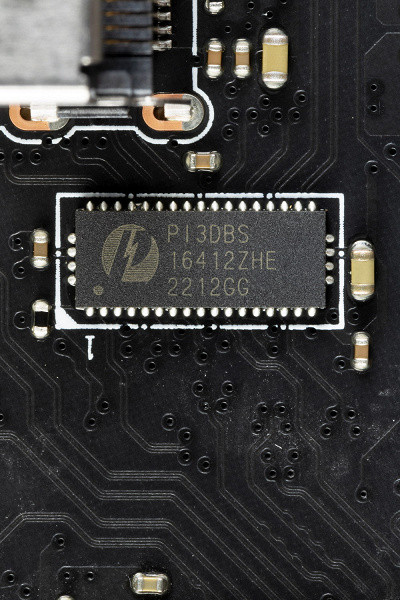
In general, I have already clearly shown everything in the slot diagram above.
All M.2 slots have heatsinks. M.2_1 and M.2_2 have separate heatsinks, while the other M.2 slots have a common heatsink.
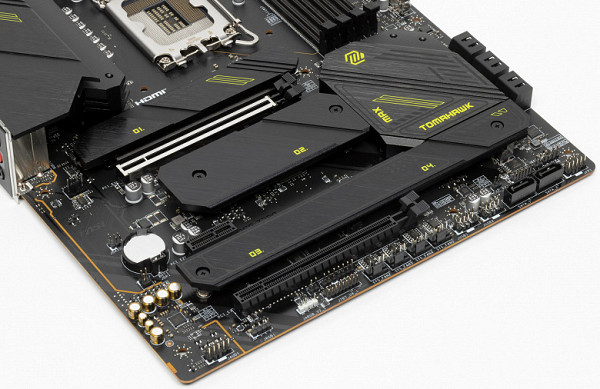
Peripheral functionality: USB ports, network interfaces, I/O
Now comes USB ports and other I/O. And let's start with the back panel, where most of them are located.

Let us emphasize once again: the Z790 chipset is capable of providing no more than 14 USB ports. Of these, there can be up to 10 USB 3.2 Gen1 ports, up to 10 USB 3.2 Gen2 ports, up to 5 USB 3.2 Gen2x2 ports and/or up to 14 USB 2.0 ports.
Taking into account also the presence of 28 PCIe lanes, which are used to support drives, network and other controllers (the distribution of 24 lanes was presented above), we have a total of 17 USB ports on this motherboard:
- 1 USB 3.2 Gen2x2 port, implemented using 2 USB 3.2 Gen2 lines from the Z790, presented as a Type-C port on the rear panel;
- 6 USB 3.2 Gen2 ports, all implemented via the Z790 and presented on the rear panel: 4 Type-A ports (red), 1 Type-C port, as well as an additional internal Type-C port.
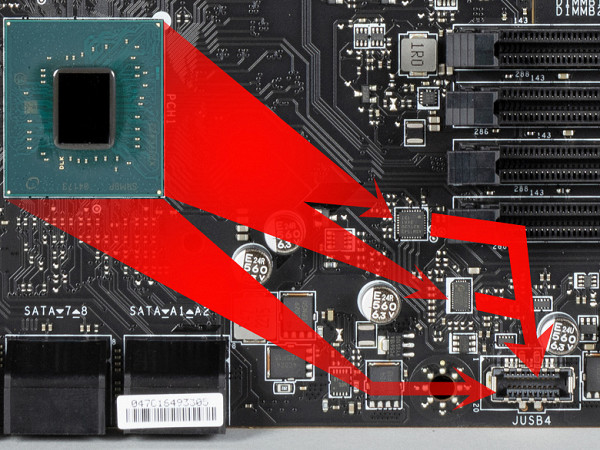
(for connection to the corresponding connector on the front panel of the case);
- 6 USB 3.2 Gen1:2 ports implemented via Genesys Logic GL3523G controller
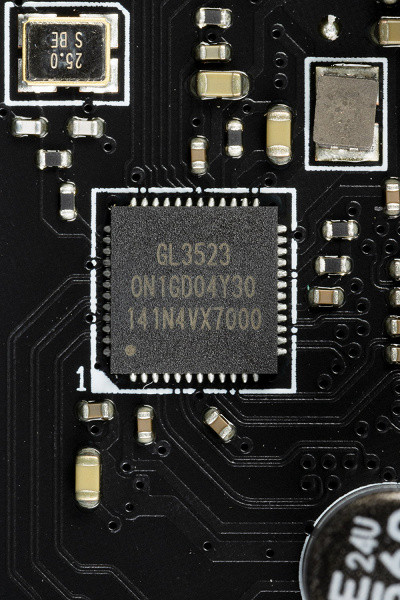
(1 USB 2.0 line is spent on it) and is represented by an internal connector on the motherboard for 2 ports);

4 more are implemented through the second Genesys Logic GL3523G controller
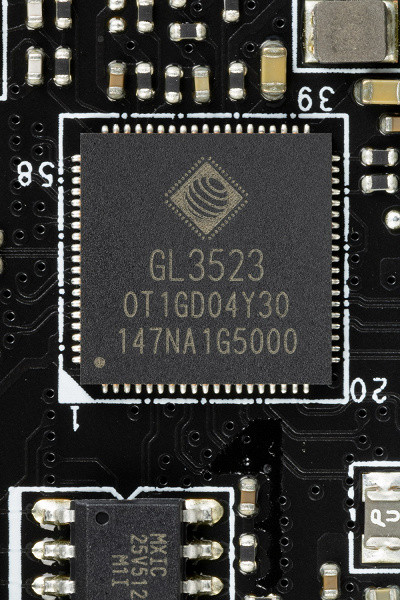
(1 USB 2.0 line is spent on it) and are represented on the rear panel by 4 Type-A ports (blue);
- 4 USB 2.0/1.1 ports: all implemented via Genesys Logic GL850G controller
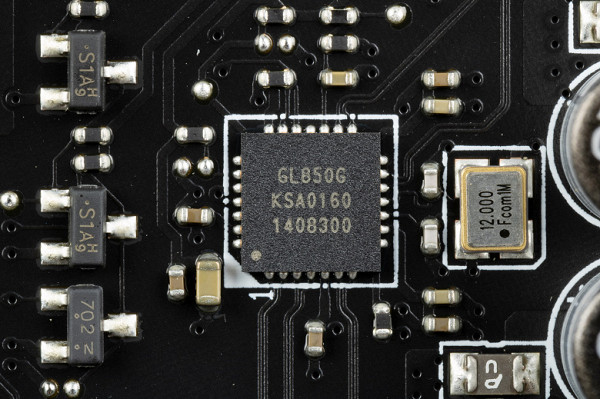
(1 USB 2.0 line is spent on it) and are represented by two internal connectors
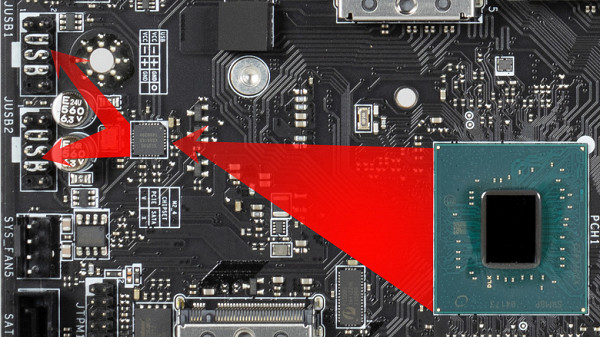
on the motherboard (each with 2 ports).
Thus, we have 5 controllers using USB lines:
- Genesys Logic GL3523 (2 USB 3.2 Gen1) ( 1 line USB 2.0);
- Genesys Logic GL3523 (4 USB 3.2 Gen1) ( 1 line USB 2.0);
- Genesys Logic GL850G (4 USB 2.0) ( 1 line USB 2.0);
- Audio ( 1 line USB 2.0);
- Bluetooth (QCNCM865) ( 1 line USB 2.0).
So, high-speed USB ports are implemented through the Z790 chipset:
- 1 dedicated USB 3.2 Gen2x2 (does not count, because it came from other HSIOs);
- + 6 dedicated USB 3.2 Gen2
- + 2 USB 3.2 Gen2 to support USB 3.2 Gen2x2
= 8 high speed ports . Don't forget that every high-speed USB port is equipped with a USB 2.0 port, that is, 8 USB 2.0 ports are already occupied. Plus 5 USB 2.0 ports to provide controllers. A total of 13 USB ports are implemented .
Well, 24 PCIe lanes allocated to support other peripherals.
In total, the Z790 in this case has 32 high-speed ports out of 38 .
All fast USB Type-C ports are equipped with re-drivers from Diodes Inc and ASMedia, which provide a stable voltage that can provide fast charging of mobile gadgets through them.



Now about networking matters.
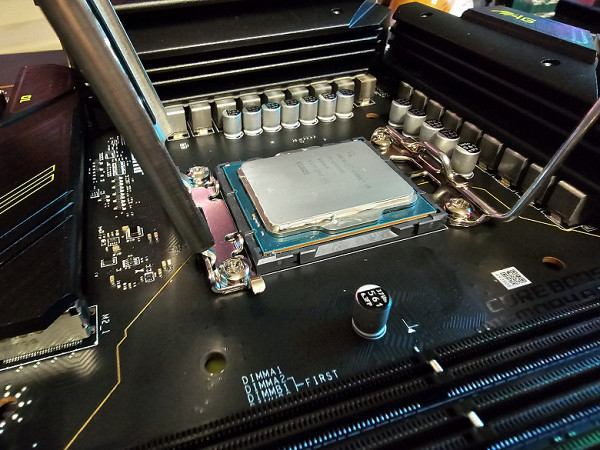
The motherboard is equipped with communication facilities well. There is a high-speed Intel i225-V Ethernet controller capable of operating according to the 2.5 Gbit/s standard.
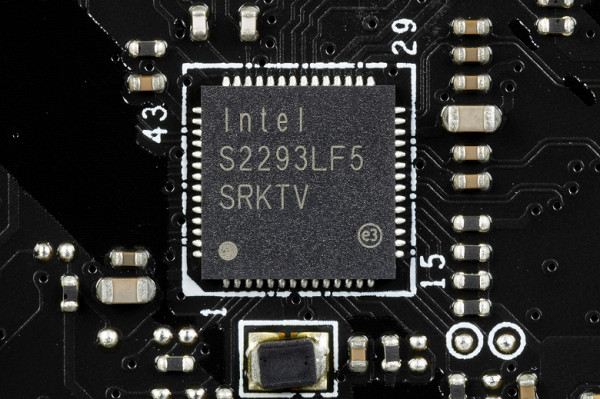
There is also a comprehensive wireless adapter on the Qualcomm QCNCM865 controller, through which Wi-Fi 7 (802.11a/b/g/n/ac/ax/be, 2.4/5/6 GHz) and Bluetooth 5.4 are implemented. It is installed in the M.2 (E-key) slot, and its connectors for screwing in external antennas are located on the rear panel.
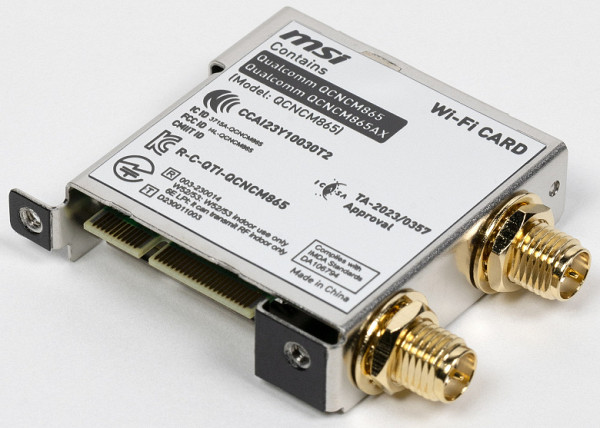

The plug, traditionally placed on the back panel, in this case is already put on and is shielded from the inside to reduce electromagnetic interference.

Audio subsystem
In this case, the Realtek ALC4080 audio codec is used. It provides audio output up to 7.1 at resolutions up to 32-bit/384 kHz.
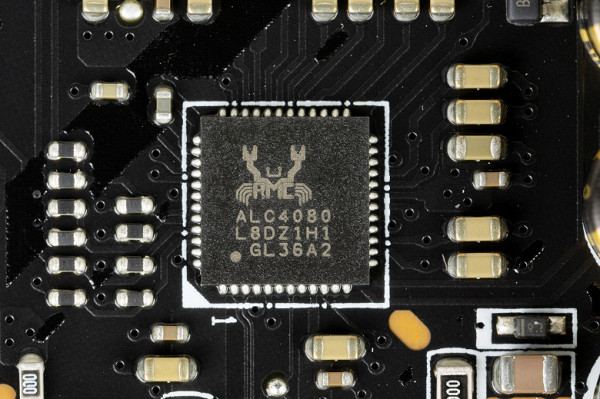
The audio circuits of the board use “audiophile” Nichicon Fine Gold capacitors.
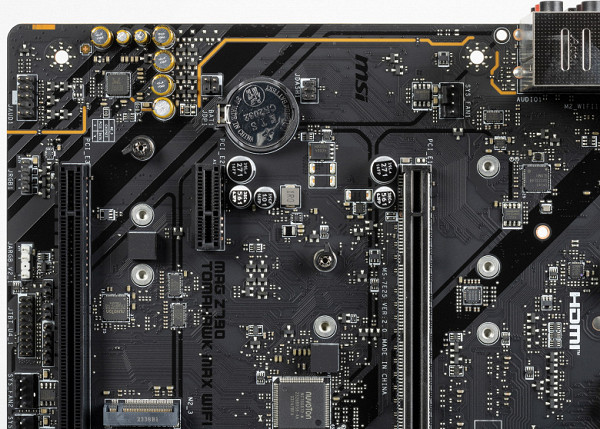
The audio path is located on the corner part of the board and does not intersect with other elements.
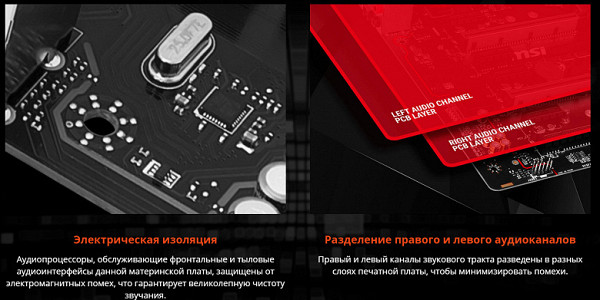
All audio connectors on the rear panel are gold-plated, but there is no usual color scheme for the connectors, so you can only navigate by the markings.
Power, cooling
To power the board, it has 3 connectors: in addition to the 24-pin ATX (it’s on the right side of the board (on the left in the photo), there are two more 8-pin EPS12V connectors.

The processor power supply circuit is made according to a 16+1+1 scheme (18 phases in total, 16 on VCore, 1 on iGPU and 1 on VCCIO).
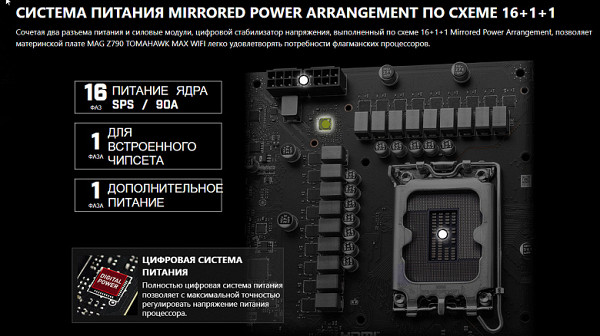
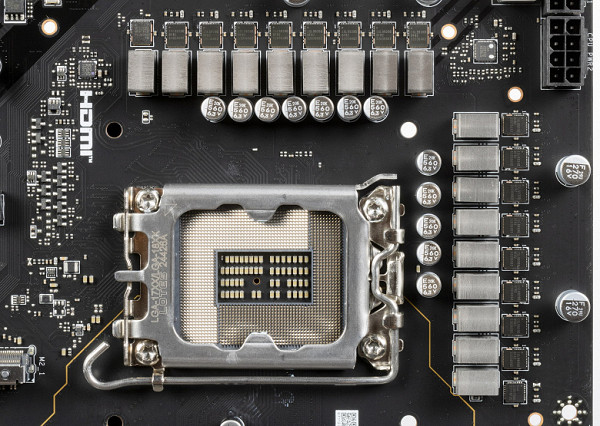
Each phase channel has a superferrite choke and a Renesas 75A RAA 220075RO MOSFET for the integrated graphics core, an ISL99390 (90A, Renesas) for the VCore and a Monolithic Power Systems MP87670 for the 70A VCCIO.
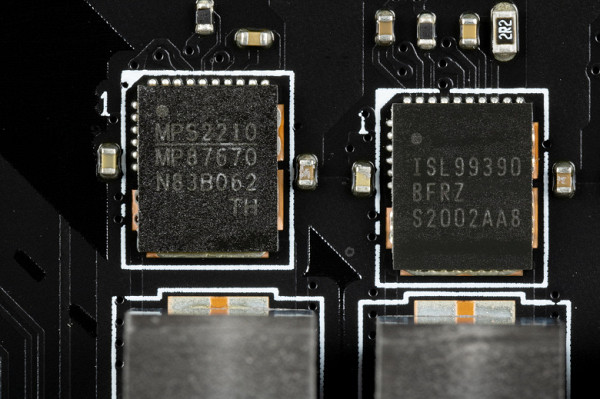
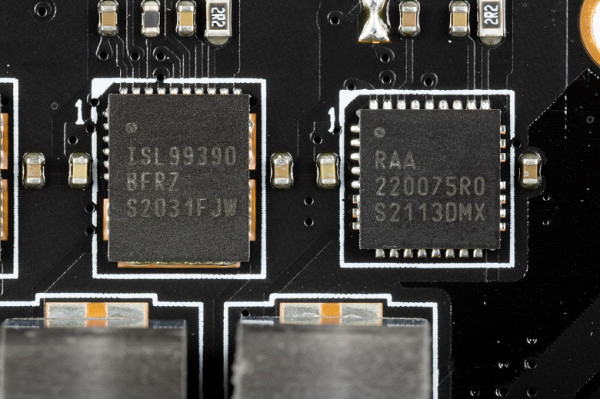
The power supply circuit for the VCore and iGPU is controlled by the RAA229132 PWM controller from the same Renesas, designed for a maximum of 12 phases.
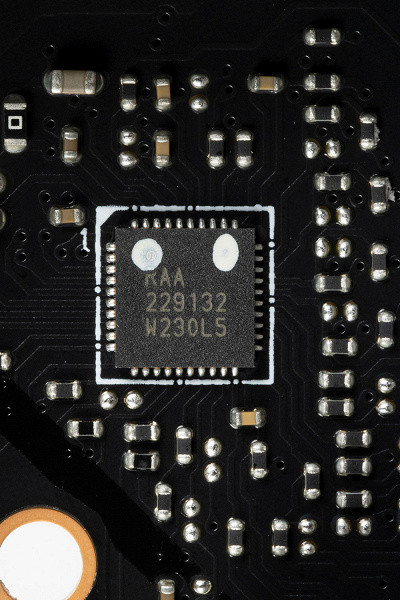
So we see that the power supply circuit must have either doublers or simply parallel flows. Looking at the back of the motherboard, we find there ISL6617A phase doublers from Renesas, just 8 pieces. So, the circuit really looks like 8x2+1+1 — only 10 real power phases, nine of them are controlled by the above-mentioned PWM controller.
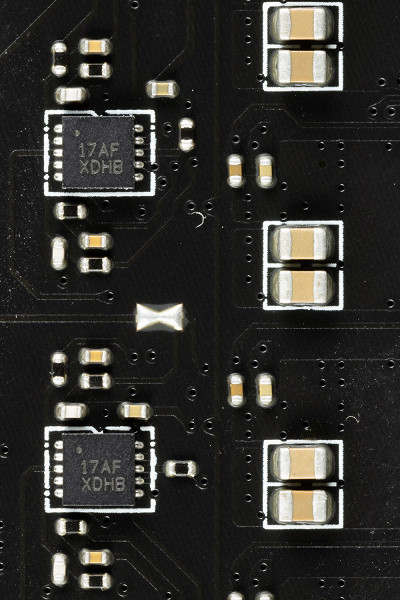
And for one VCCIO phase there is its own PWM controller from Monolithic Power Systems.

The VCCSA power supply is single-phase.
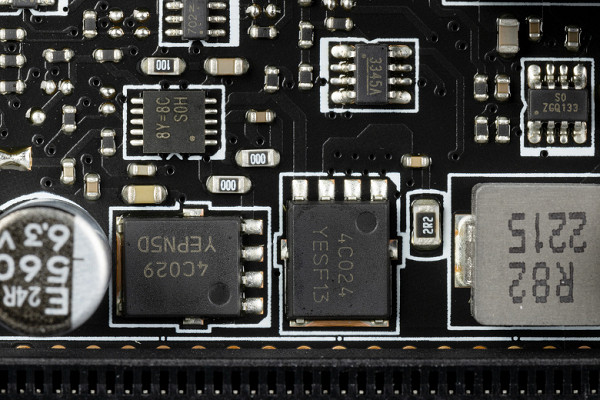
Now about cooling.
All potentially very hot elements have their own heat sinks.

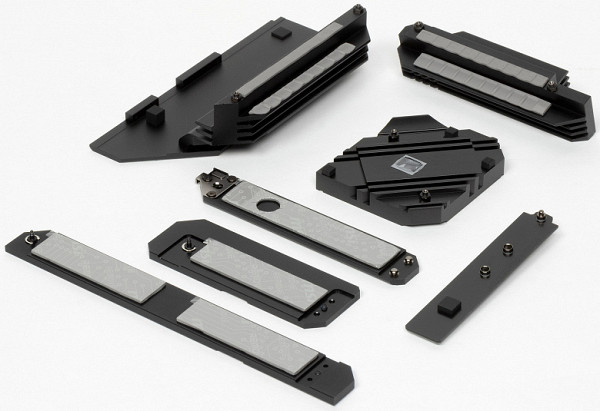
As we can see, the cooling of the chipset (one radiator) is organized separately from the power converters. The VRM sections have their own two separate radiators.
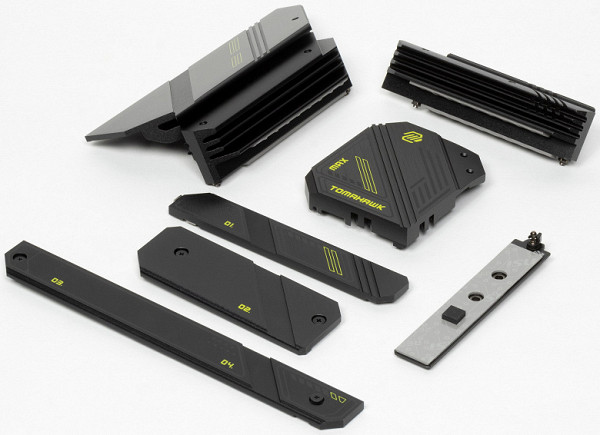
As mentioned earlier, each of the M.2 slots has its own heatsink: the top and middle slots have individual heatsinks, while M.2_3 and M.2_4 share a common heatsink.
It is strategically important to note the new method of mounting the heatsink for the M.2_1 — a snap-on system. This greatly simplifies the process of installing and dismantling the radiator, eliminating the need to use a screwdriver and saving time on turning screws.
Backlight
In this case, the motherboard itself does not have a backlight.
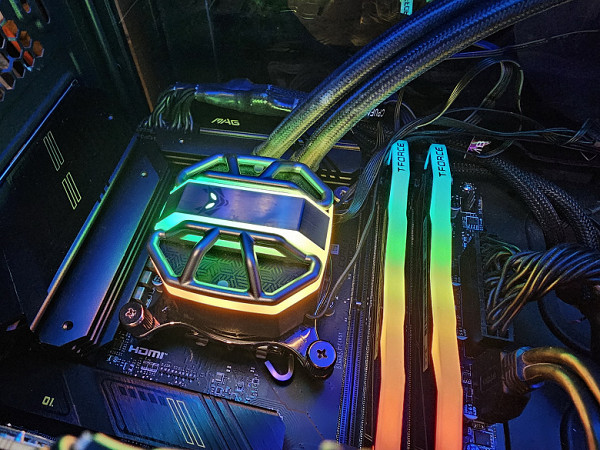
But at the same time, there are 3 connectors for connecting external lighting, and all this can be controlled through the Mystic Light section in the comprehensive MSI Center utility.

Windows software
All software can be downloaded from the manufacturer's website msi.com. Essentially, this is one global program — MSI Center. Actually, all other utilities are now included in it.
First, let's look at the Mystic Light backlight control section. The utility has 25 (!) lighting options for elements of the board's lighting system (three ARGB connectors + an RGB connector). You can select the lighting mode for both individual elements and the entire group as a whole. And, of course, you can turn off the backlight altogether. The utility also determines the presence of video cards from MSI and memory modules from a number of well-known manufacturers.

The backlight can be synchronized (though then there will be fewer options).
MSI Center also monitors the operation of main units as a whole.
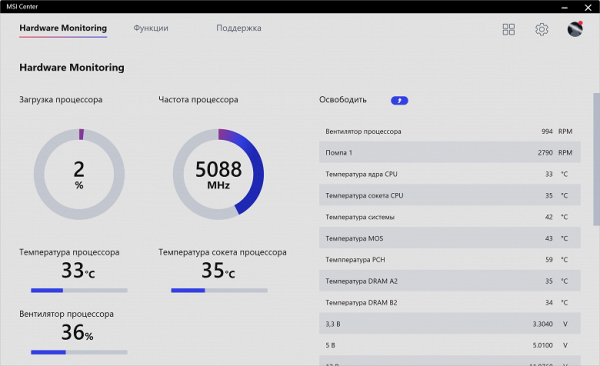
It is possible to enable monitoring as a separate window, which is easy to switch, especially if the number of marked items exceeds its size. This window can be conveniently placed on the side of the screen to make it easier to monitor the state of the hardware, for example, during overclocking or intense load in a game. However, in this case, you may have to abandon the «full screen» mode in the game.
MSI Center provides two themes: light and dark.
Naturally, in addition to backlight control and monitoring, this program also provides many other built-in utilities.
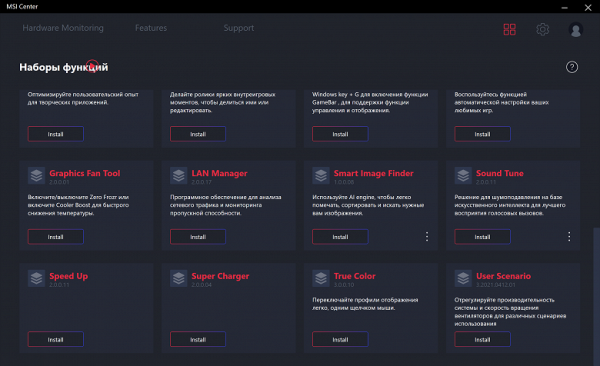
For automatic overclocking without entering the BIOS, there is a tab with preset settings for frequencies and voltages.
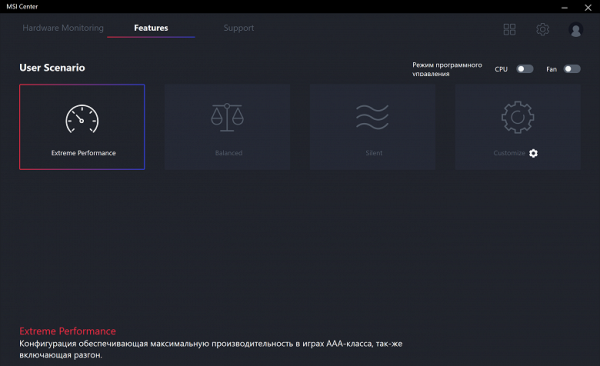
There is also a tab for managing network connections: the program will allow the user to organize access to network connections from a particular application. This is sometimes necessary to organize the fastest exchange of information, for example, for games.
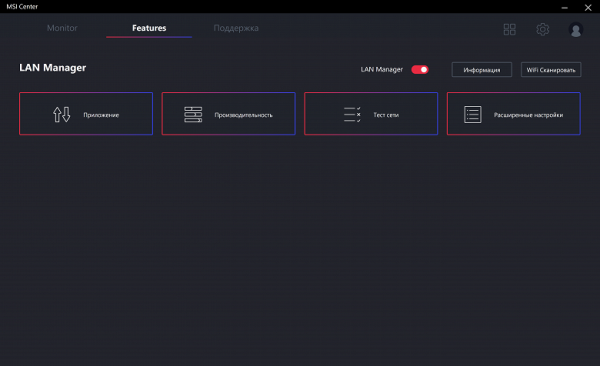
We should also note the proprietary sound control panel from Nahimic, which accompanies the current Realtek audio driver.
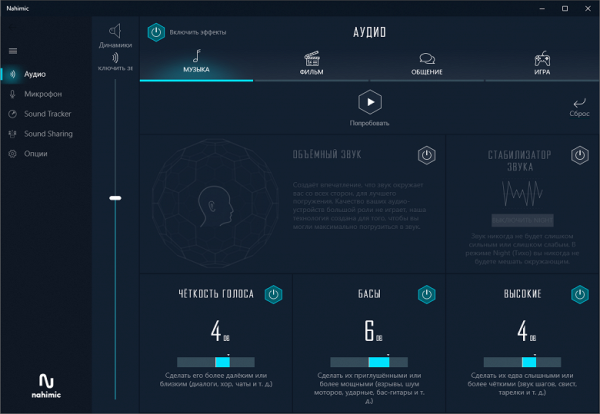

Actually, you can customize the sound “to suit you” both in games and simply when listening to music. Particularly interesting are the settings for audio output to headphones.
BIOS Settings
All modern boards now have UEFI (Unified Extensible Firmware Interface), which are essentially operating systems in miniature. To enter the settings when booting the PC, you traditionally need to press the Del or F2 key.
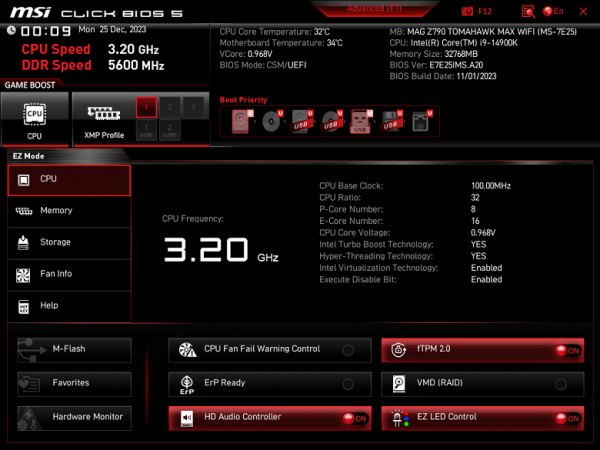
We find ourselves in a general “simple” menu, where essentially there is only one information (with an easy selection of a number of options), so we press F7 and we find ourselves in the “advanced” menu.


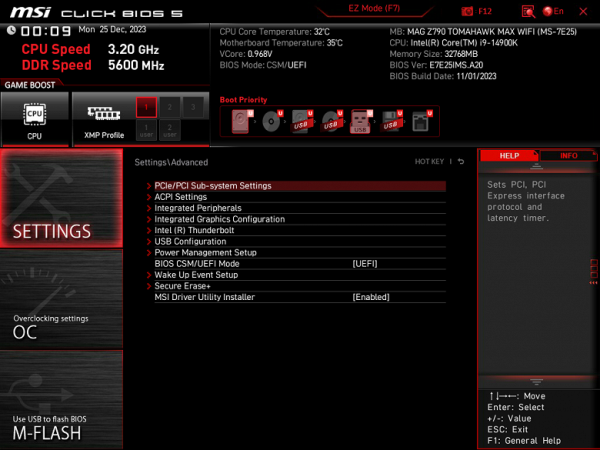
Advanced settings. There are many interesting positions where each USB port can be controlled. How to change the operating modes of PCIe and M.2 slots. Particular attention should be paid in the section to the management of M.2 and SATA, which share resources among themselves, as well as the operating mode of the PCI_E1 and M.2_1 slots, which also share resources.
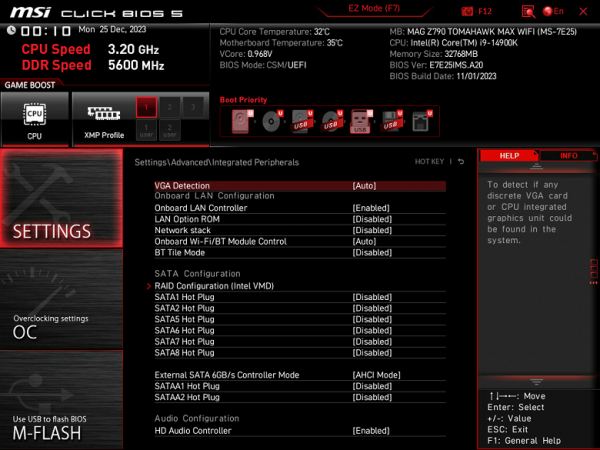
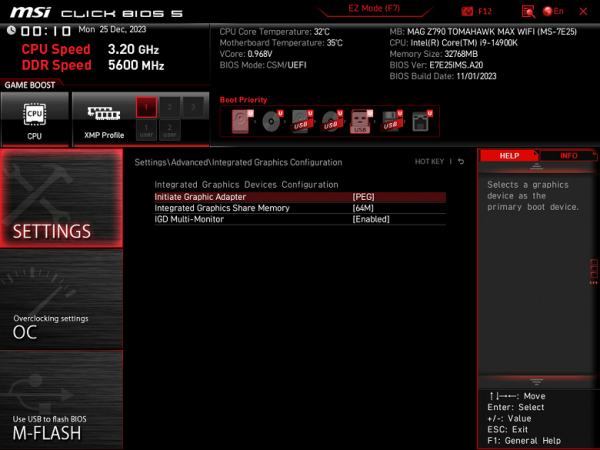
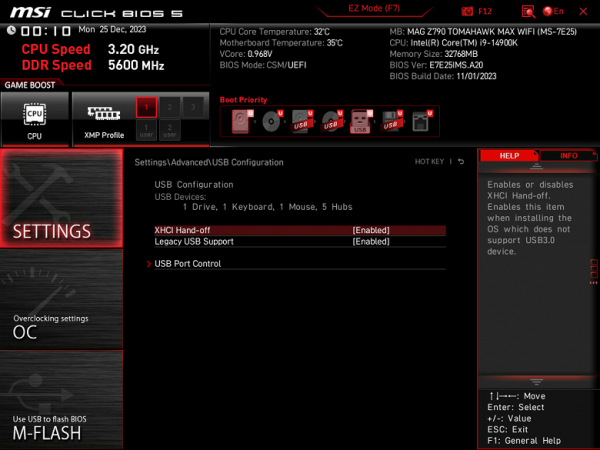
Monitoring and boot menu options are well known to everyone. In the monitoring section you can configure the operation of the fan slots.
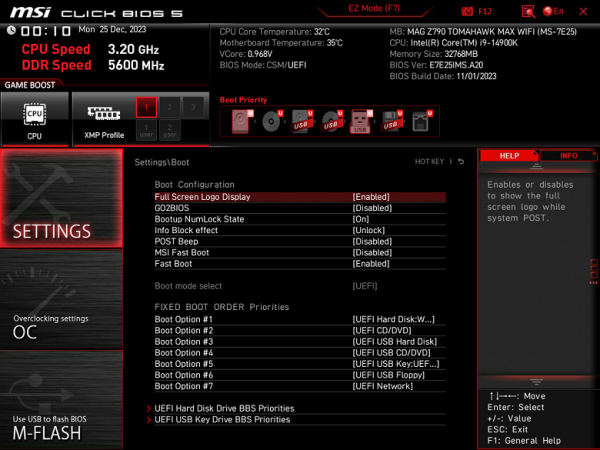
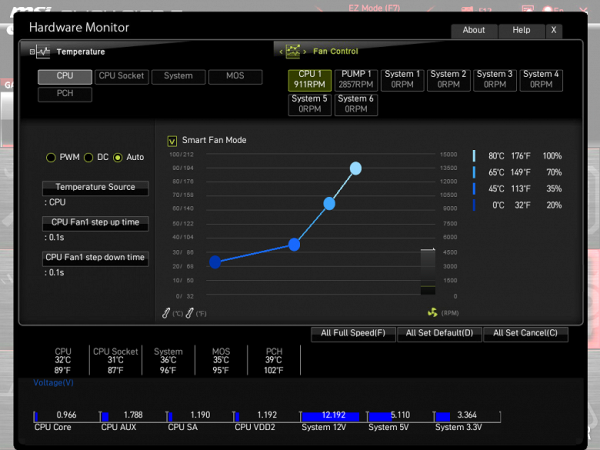
The range of overclocking options in this motherboard is more moderate compared to models from the MEG family. However, for today's high-end processors, many of these options may seem unnecessary, given that the processors themselves already operate at high frequencies thanks to Intel TurboBoost technology, not to mention Multi-Core Enhancement (MCE).
Practice shows that the efficiency of overclocking largely depends on the capabilities of the processor cooling system.
It is important to note the Multi-Core Enhancement (MCE) technology based on TurboBoost. It involves removing any restrictions on power consumption, allowing the CPU frequency to rise as much as possible until it reaches the temperature limit. For those who strive to stay within their TDP limits, it is recommended to disable MCE.
Performance (and overclocking)
Full test system configuration:
- MSI MAG Z790 Tomahawk Max WiFi motherboard;
- Intel Core i9-14900K processor 4.5-5.8 GHz;
- RAM TeamGroup T-Force Delta RGB 32 GB (2×16) DDR5 (CL36-46-46-84) (XMP 7600 MHz);
- SSD drive Gigabyte Aorus Gen4 SSD 500 GB (GP-AG4500G);
- Palit GeForce RTX 3050 StormX video card;
- power supply Super Flower Leadex Platinum 2000W (2000 W);
- LSS Sapphire Nitro+ S360-A AIO CPU Cooler ;
- TV LG 55Nano956 (55″ 8K HDR);
- USB — keyboard and mouse.
Software:
- operating system Windows 11 Pro, 64-bit
- AIDA 64 Extreme
- 3DMark Time Spy CPU benchmark
- 3DMark Fire Strike Physics benchmark
- 3DMark Night Raid CPU benchmark
- HWInfo64
- OCCT v.12.1.14
- Adobe Premiere CS 2019
We launch everything in default mode (but at the same time activate MCE). Then we load it with tests.
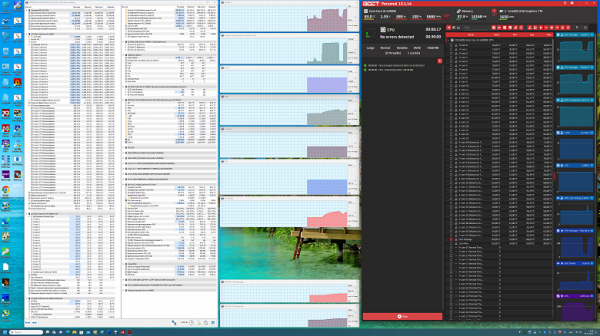
In auto-overclocking mode, we managed to reach a frequency of 5.7 GHz on all P-cores and 4.4 GHz on all E-cores. Recall that P cores are performance cores with two threads each, where «P» stands for Performance, while E cores are power-efficient, small cores with a single thread. In general, the system, having detected the powerful power supply of the motherboard, automatically configured significant auto-overclocking. It is important to note that all other system parameters related to the thermal characteristics of the components remained normal.
Considering that this motherboard is not an overclocker and belongs to the simpler MAG series of gaming boards, this level of auto-overclocking is more than sufficient.

conclusions
The MSI MAG Z790 Tomahawk Max WiFi motherboard is a modern and improved solution within the MAG gaming series with an estimated cost of about 35 thousand rubles. This model is designed to be compatible with 12/13/14th generation Intel Core processors and is aimed at a wide range of users, including not only gamers.
The board provides 17 USB ports, including 6 high-speed USB 3.2 Gen2 and 1 USB 3.2 Gen2×2. It is equipped with two PCIe x16 slots: one of them is connected to the processor via 16 PCIe version 5.0 lanes, and the second is connected to the chipset and operates in x4 mode. There are 4 M.2 slots built in: one directly to the processor to support PCIe 5.0, and the other three to the Z790 chipset with PCIe 4.0 lanes.
The board also has 8 SATA ports and 8 fan headers. A powerful processor power supply ensures stable operation with overclocking capabilities. Efficient cooling is distributed across all critical components, including M.2 slots. Network features include a fast 2.5 Gbps wired controller, as well as a modern wireless module with Wi-Fi 7 and Bluetooth 5.4. A plus is also the extensive possibilities for connecting RGB lighting devices.
